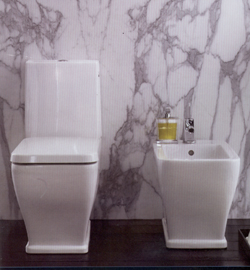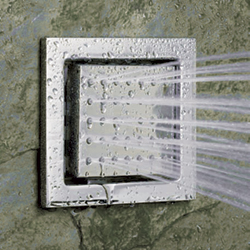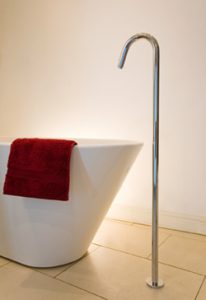Saving Water in the Bathroom
The bathroom is where the average household uses the most water, and just a few small changes can produce huge savings.
The Toilet
The toilet probably accounts for the biggest percentage of water consumption in your home.
The majority of homes in the UK still have old-fashioned cisterns that use an average of 13litres per flush.
More modern cisterns only use about 7-8 litres per flush, while dual flush cisterns use about 6-7 litres for a full flush and a half flush uses about 3 litres.
If you are not able to have a dual flush cistern there are still things you can do to reduce your water consumption. Some water companies give their customers free Cistern Displacement Devices (when we were kids living through a drought I remember my dad putting a couple of bricks in the cistern).
The average home flushes their toilet about 5000 times a year, so even small reductions will produce massive savings. Most CDDs will reduce the flush by anything between 1 and 3 litres, achieving savings of 5000 litres and more – that’s a lot of water!
The other thing to keep an eye out for is a leaking cistern. Leaking Cistern can waste as much as 12 litres of water in an hour. So if you have a suspiciously high water bill, and you cannot figure out where all this water is that you are paying for, your cistern may very well be leaking. Below are some tips on how to check if your cistern is leaking:
- Listen for a low humming noise. This is the result of the cistern having to constantly take in more water as water escapes it via the leak. However, a silent cistern can also be a leaky one, and you should try some other methods even if you cannot hear a hum.
- A very effective way of checking if your cistern is leaking is to put some food colouring into your cistern. Check the pan after an hour or so. If there is any sign of food colouring in the pan without you having flushed, it is because your cistern is leaking.
- If your cistern is leaking the most cost-effective solution may well be to replace it with a modern dual flush cistern.
Bathing or Showering
 Showers have become more popular in the last couple of decades with about 80-90% of homes now having a shower – in fact some smaller homes now don’t include a bath
Showers have become more popular in the last couple of decades with about 80-90% of homes now having a shower – in fact some smaller homes now don’t include a bath
We’ve been told often enough that showering uses less water than bathing but that depends on how you use them. Apart from significant water savings efficient bathing and showering can reduce energy bills too.
The average shower uses about 62 litres of water, although some power showers can use up to 136 litres whereas the average bath only uses 80 litres.
These figures are all a bit imprecise, as there is a lot you can do to improve the efficiency of both your bath and your shower.
Bathing can be more efficient if you only use as much water as you need – don’t fill it all the way to the top
Shower efficiency can be improved by taking quicker showers – you can sing , bring about world peace and plan your date with the office heart throb just as well after your shower! Even a minute or two will make a difference.
Fit a new shower head, it can make a world of difference, especially the new aerated or low-flow shower heads. Although be sure you choose one that works with your shower system.
There are a couple of slightly more off-the-wall suggestions we’ve come cross – shower with a friend, shower less frequently- although we suspect it would be tricky to manage both of those!
Remember, it’s more than just cutting costs, water is a valuable commodity and we don’t want to waste it.
Visit our main site at www.livinghouse.co.uk or call us on 01722 415000 to find out how we can make your bathroom more efficient

Leave a Reply